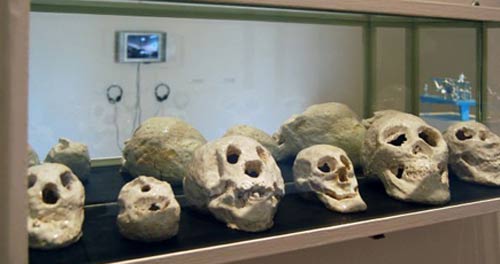Double Agent, Institute of Contemporary Arts, London
Fancy an installation? I'll get my best people on to it right away

One of the newer things about the art of the past 40 years has been the part played in it by proxies. From the moment in 1960-odd when Sol LeWitt asked gallery assistants to do his drawings for him, other people have become as common a material in the making of art as pastel or gouache. Why this should be and what it means are questions you can ponder as you walk around the Institute of Contemporary Arts' show Double Agent.
Double Agent looks at seven artists who get stand-ins to do their work for them. This sounds like a broad remit, and it is. To my mind, the only problem with this show – and it is a very, very good piece of curating – is that it goes both too far and not far enough. The aesthetic of ex-YBAs such as Damien Hirst and Marc Quinn lies in the fact that other people make their art for them. Those proxies – vitrine builders, cryogenic engineers and the rest – aren't actually present in the work, but they do allow the artists to be patently absent from it. That absence is at the heart of Double Agent, and yet the YBAs aren't alluded to. On the other hand, the artists who are included seem so diverse in their practice that you wonder whether they aren't being squeezed to fit. Still, Double Agent flags up an important issue in contemporary art-making, and the work in the show is uniformly excellent.
The most poignant of it comes from two Polish artists, Pawel Althamer and Artur Zmijewski, shown side by side in the ICA's upper galleries. Althamer works with a class of multiple sclerosis patients who make ceramics; Zmijewski invited four special-interest groups – of Catholics, Jews, socialists and Polish nationalists – to produce banners symbolising their beliefs, and then to let the other groups edit or change them.
The crude pieces made by Althamer's ceramicists raise difficult questions – whether we should see them as fine art or Outsider Art, whether or not Althamer's handling of his proxies is in some way exploitative. (The question of the relationship of artist to proxy is central to this show.)
The outcome of Zmijewski's experiment, a video called Them, is depressingly predictable. Starting with high-minded sloganeering – "Our work should show that we consider all people equal" – the project quickly degenerates into black farce: socialists screaming "WE DEMAND TOLERANCE!" while flicking paint at nationalists; Jews throwing Catholic work out of the window and having their own burned in revenge. As with Althamer, the unasked question in all of this is where Zmijewski himself stands – what it means that he set up this experiment and filmed it, whether he is a force for good or a political Pavlov.
This is fascinating stuff, although I can't really see what it has to do with Phil Collins's equally interesting photographs in the corridor downstairs. Collins invited a number of art world titans to his studio, where he slapped them in the face and photographed them. Two of his subjects are Double Agent's curators, whose burning cheeks and dilated pupils suggest Collins's blow was something more than conceptual. Presciently called You'll Never Work in This Town Again, the series, in terms of portraiture, is actually rather traditional in trying to find a way behind the sitter's mask. How this makes Collins's subjects proxies for his art-making – or at least any more so than any other portrait sitter is a proxy – I really can't say.
By contrast, Barbara Visser's 20-minute video, Last Lecture, is all about stand-ins. Visser's film shows her fielding questions from an audience about an earlier work which plays on a screen behind her. Actually, neither Visser is the real artist, her part in each film being played by a different actress. In front of these, flat in silhouette against the screen, sits Visser herself, silently pondering a script. We can't see her face or hear her voice. "What the viewer sees depends on what they are looking for," intones one of the pseudo-Vissers; which epigram sums Last Lecture up nicely, until you realise it has been spoken by a fake. And that truth – that art is never quite the revelation it seems – is what Double Agent is all about.
Institute of Contemporary Arts, London SW1 (020-7930 3647) to 6 April
Subscribe to Independent Premium to bookmark this article
Want to bookmark your favourite articles and stories to read or reference later? Start your Independent Premium subscription today.

Join our commenting forum
Join thought-provoking conversations, follow other Independent readers and see their replies
Comments